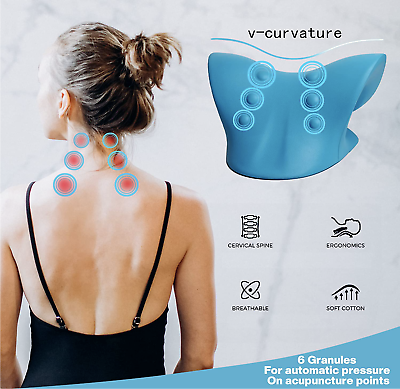Neck Cloud: Innovative Assistance for Discomfort Alleviation and Better Posture
Neck Cloud: Innovative Assistance for Discomfort Alleviation and Better Posture
Blog Article
Neck Pain in the Office: Determining Threat Elements and Applying Ergonomic Solutions
Neck pain in the office is a prevalent problem that can impact worker health and productivity. By comprehending the numerous risk aspects adding to neck pain and applying ergonomic solutions, organizations can create a more conducive work environment.
Common Root Causes Of Neck Pain
Neck pain in the workplace is a common issue that can be connected to a number of common reasons. Furthermore, recurring movements such as frequent bending, turning, or getting to can also add to neck pain over time.

Ergonomic Danger Factors
Poor comfort designs in the work environment can substantially contribute to neck discomfort amongst employees. Variables such as incorrect workdesk height, poor chair support, and unpleasant positioning of computer system monitors can all play a duty in the development of neck pain. When employees are compelled to sit for extensive periods ready that stress their neck muscles, it can bring about tightness, soreness, and much more significant bone and joint issues in time.
In addition, poor ergonomic methods can cause employees embracing uncomfortable stances while working, such as craning their necks to see a computer screen or getting to annoyingly for a mouse or keyboard. neck cloud. These repeated motions and abnormal positions can place undue stress on the neck and bordering muscles, bring about discomfort and reduced performance

Desk Configuration Recommendations
When establishing a workdesk in the workplace, it is necessary to pay interest to the comfort designs of the setting. To minimize the risk of neck pain and discomfort, there are several desk setup recommendations that workers ought to think about. First of all, make sure that the computer system screen is positioned at eye level to stop straining the neck by searching for or down. The keyboard and mouse should be put at a height where the elbow joints are bent at a 90-degree angle to promote proper wrist placement. In addition, the chair elevation need to permit the feet to relax flat on the floor with thighs alongside the ground.
It is additionally vital to have appropriate illumination to decrease eye strain, as scrunching up your eyes or leaning ahead can look at this web-site lead to neck stress. Organize the workdesk design to keep often made use of products within arm's reach, limiting the requirement for site repetitive turning or reaching movements. By applying these desk arrangement suggestions, employees can develop a much more ergonomic workspace that sustains neck health and minimizes the risk of creating job-related neck pain.
Extending and Exercise Tips
To preserve flexibility and minimize muscle tension in the workplace, integrating stretching and exercise routines can be valuable for total well-being and performance. Straightforward desk-friendly stretches can help reduce neck discomfort and avoid rigidity. Neck rolls, shoulder shrugs, and gentle side-to-side neck stretches work in relieving stress. In addition, incorporating workouts like chin tucks, shoulder blade presses, and upper back stretches can assist reinforce muscles that support excellent posture.
Setting reminders or utilizing applications that trigger motion can help establish a regular stretching regimen. By focusing on these tasks, you can boost your physical wellness, minimize the danger of neck pain, and enhance your overall performance in the office.
Relevance of Normal Breaks
In a hectic job atmosphere where demands can add to physical pressures like neck discomfort, establishing a routine that stresses the significance of regular breaks is vital. By incorporating brief breaks into the job routine, staff members can minimize the threat of establishing neck discomfort and enhance total comfort and performance.
Regular breaks enable employees to rest their muscular tissues, stretch, and alter placements, avoiding rigidity and promoting far better circulation. Motivating employees to take short breaks every 30-60 mins can help in reducing the accumulation of tension in the neck and shoulders. These breaks can additionally act as a possibility for employees to practice leisure techniques or gentle neck stretches, better promoting musculoskeletal wellness. Implementing a culture that values and focuses on regular breaks can have a considerable effect on reducing neck pain and enhancing overall wellness in the office.
Verdict
Finally, resolving ergonomic risk variables and implementing proper workstation setups are necessary in lowering neck discomfort in the work environment. By advertising great stance, giving sufficient support, and motivating routine breaks and stretches, organizations can More Help create a healthier and much more productive workplace for workers. Prioritizing worker well-being through ergonomic services is essential to stopping pain and improving general office complete satisfaction.
Neck discomfort in the office is a prevalent issue that can affect worker well-being and efficiency. By determining and addressing these typical reasons of neck pain in the work environment, companies can take proactive steps to create a more ergonomic and comfortable job setting for their workers.
Poor comfort designs in the office can dramatically add to neck pain among staff members. By executing these workdesk configuration referrals, employees can produce an extra ergonomic work area that sustains neck health and wellness and decreases the danger of establishing occupational neck discomfort.
Neck rolls, shoulder shrugs, and gentle side-to-side neck stretches are efficient in relieving stress.
Report this page